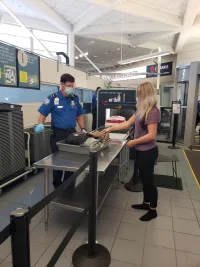The Transportation Security Administration (TSA) has begun using a state-of-the-art computed tomography (CT) scanner in the security checkpoint at Orlando Melbourne International Airport (MLB).
“The technology employs a sophisticated algorithm to analyze the content of each bag and allows TSA officers to rotate the image and ascertain that no threats are contained in the bag without needing to open the suitcase,” said TSA Federal Security Director Pete Garcia. “Reducing the number of bags that need to be manually inspected to resolve a possible threat, means fewer touchpoints during the pandemic.”
When the CT is in use, travelers do not need to remove electronics, food or travel-size liquids from carry-on luggage. Passengers in the TSA Precheck program have that benefit regardless of whether the CT is in use and all travelers are encouraged to sign up for the program.
“We are grateful for our longstanding partnership with TSA and the recent upgrades to our checkpoint, which build on providing an even safer and more convenient experience for our travelers,” said Greg Donovan, executive director at Orlando Melbourne International Airport (MLB). “This is just a glimpse of what’s to come with our terminal expansion project that is underway to prepare for increases in passenger traffic. Plans for a new and expanded TSA checkpoint, along with advanced technology like this, including touchless protocols, will more than double our throughput capabilities.”
In addition to the use of technology, TSA has modified its procedures at airports across the country as part of its “Stay Healthy. Stay Secure.” campaign. Departing travelers can expect to see:
- All security officers wearing face masks and gloves during the screening process. If a security officer is working in close proximity to travelers, they are also required to wear eye protection or a face shield. Security officers will change their gloves after each screening position rotation, after a pat-down or upon a passenger’s request
- Reduced physical contact due to the installation of acrylic barriers that limit exposure between security officers and travelers when presenting their boarding pass and ID.
- Social distancing leading up to and in the security checkpoint environment.
- And through our partnership with Orlando Melbourne International Airport, increased frequency and intensity of cleaning and disinfecting surfaces in the security checkpoint including bins. This is no substitute for practicing good hygiene while traveling. Travelers are encouraged to wash their hands before and after going through the checkpoint.
Additional tips for traveling this holiday season include:
Step 1: Pack smart
Travelers should be aware of the contents of their carry-on bags and make sure they are not bringing prohibited items to the security checkpoint. To determine whether an item is allowed or prohibited in carry-on luggage, go to TSA.gov and use the “Can I Bring?” feature. Or @AskTSA on Twitter. By planning ahead, travelers can avoid a bag check and reduce the potential for cross-contamination.
Step 2: Wear a mask
TSA strongly recommends all travelers wear a face covering throughout the entire travel experience. Travelers may be asked to adjust their mask for ID verification or if it alarms during the security screening process. If a traveler does not have a mask and they require a pat-down, a security officer will provide a mask.
Step 3: Secure items in your carry-on
When removing items from pockets such as phones, keys, lip balm, tissues and loose change, travelers should secure those items into their carry-on bags instead of placing them in bins. Bins are a common use item and travelers should use caution when placing personal items in them.
Step 4: Traveling with food
In general screening lanes, food items should be packed in a clear plastic bag and placed in a bin for screening. This simple step further reduces the potential for cross-contamination and avoids having food sit directly in bins. If you are planning to travel with special foods to contribute to a Thanksgiving meal, be sure you follow this simple rule to ensure your food can travel with you: If you can spill it, spread it, spray it, pump it or pour it, pack it in a checked bag. For example, cranberry sauce, gravy and wine in quantities larger than 100 ml or 3.4 ounces should go in a checked bag. Cakes, pies and casseroles can travel in carry-on luggage.
Step 5: Traveling with hand sanitizer
Remember the 3-1-1 rule for your liquids, gels and aerosols, with one exception: TSA is currently allowing one oversized liquid hand sanitizer container, up to 12 ounces per passenger, in carry-on bags. Please remove the hand sanitizer from the carry-on bag and place it in a bin for screening. Passengers may also bring hand wipes of any size or quantity through.

